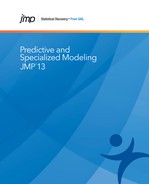Chapter 17
Response Screening
Test Many Responses in Large-Scale Data
The analysis of large-scale data sets, where hundreds or thousands of measurements are taken on a part or an organism, requires innovative approaches. But testing many responses for the effects of factors can be challenging, if not misleading, without appropriate methodology.
Response Screening automates the process of conducting tests across a large number of responses. Your test results and summary statistics are presented in data tables, rather than reports, to enable data exploration. A False-Discovery Rate approach guards against incorrect declarations of significance. Plots of p-values are scaled using the LogWorth, making them easily interpretable.
Because large scale data sets are often messy, Response Screening presents methods that address irregularly distributed and missing data. A robust estimate method allows outliers to remain in the data, but reduces the sensitivity of tests to these outliers. Missing data options allow missing values to be included in the analysis. These features enable you to analyze your data without first conducting an extensive analysis of data quality.
When you have many observations, even differences that are of no practical interest can be statistically significant. Response Screening presents tests of practical difference, where you specify the difference that you are interested in detecting. On the other hand, you might want to know whether differences do not exceed a given magnitude, that is, if the means are equivalent. For this purpose, Response Screening presents equivalence tests.
Figure 17.1 Example of a Response Screening Plot

..................Content has been hidden....................
You can't read the all page of ebook, please click here login for view all page.
